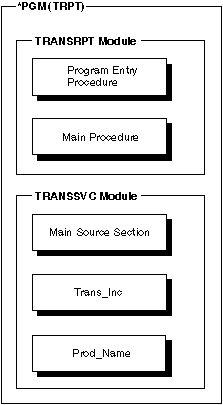Binding Modules into a Program
Binding is the process of creating a runnable ILE program by combining one or more modules and optional service programs, and resolving symbols passed between them. The system code that does this combining and resolving is called a binder on the IBM® i.
As part of the binding process, a procedure must be identified as the startup procedure, or program entry procedure. When a program is called, the program entry procedure receives the parameters from the command line and is given initial control for the program. The user's code associated with the program entry procedure is the user entry procedure.
If an ILE RPG module contains a main procedure, it implicitly also contains a program entry procedure. Therefore, any ILE RPG module may be specified as the entry module as long as it is not a NOMAIN module.
Figure 1 gives an idea of the internal structure of a program object. It shows the program object TRPT, which was created by binding the two modules TRANSRPT and TRANSSVC. TRANSRPT is the entry module.

Within a bound object, procedures can interrelate using static procedure calls. These bound calls are faster than external calls. Therefore, an application consisting of a single bound program with many bound calls should perform faster than a similar application consisting of separate programs with many external interapplication calls.
In addition to binding modules together, you can also bind them to service programs (type *SRVPGM). Service programs allow you to code and maintain modules separately from the program modules. Common routines can be created as service programs and if the routine changes, the change can be incorporated by binding the service program again. The programs that use these common routines do not have to be recreated. For information on creating service programs see Creating a Service Program.
For information on the binding process and the binder, refer to the ILE Concepts.